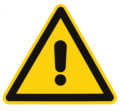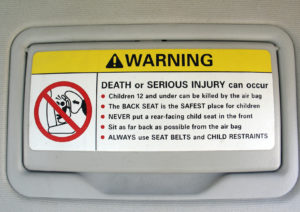WARNING! If You Assume Your Case Will Survive Because You Have a “Creative” Warnings Expert, You Do So At Your Own Risk
 Those of us in the business of defending products look at the world in a slightly different way. When I come across a warning label, I actually study it because in a failure to warn case, the language of the warning, the color of the label and its location on the product are relevant to the effectiveness of the warning. In my experience defending manufacturers of various types of products, I have seen plaintiffs make speculative failure to warn claims. Less-experienced plaintiffs’ attorneys assume that a creative theory developed by a well-credentialed “warnings expert” will be enough to leverage a settlement in an otherwise weak case on liability. That is a dangerous assumption to make.
Those of us in the business of defending products look at the world in a slightly different way. When I come across a warning label, I actually study it because in a failure to warn case, the language of the warning, the color of the label and its location on the product are relevant to the effectiveness of the warning. In my experience defending manufacturers of various types of products, I have seen plaintiffs make speculative failure to warn claims. Less-experienced plaintiffs’ attorneys assume that a creative theory developed by a well-credentialed “warnings expert” will be enough to leverage a settlement in an otherwise weak case on liability. That is a dangerous assumption to make.
The case law in all jurisdictions is clear when it comes to the burden of proof for a warnings claim; there has to be a direct link between the failure of the manufacturer to warn about the hazard and the cause of the incident. Moreover, the plaintiff’s expert must consider, among many other things, all of the available accident data and not rely only on select facts from the record to support his findings. A manufacturer who is facing a speculative warnings claim has a few options for dealing with these types of claims. The most effective and frequently used tool is the Daubert motion to exclude the expert from testifying at trial.
For example, if the plaintiff’s expert has not drafted an alternative warning that he believes would have avoided the incident if used by the defendant-manufacturer, the defense should move to have that expert excluded. Courts have routinely held that the testimony of a warnings expert who has not drafted an alternative warning is unreliable. In addition, the expert must be able to show that the warning has been subjected to peer review and accepted by the relevant scientific community.
For the most part, courts will also require that the expert have some experience with the type of product that is the subject of the case. For example, in Calisi v. Abbott Laboratories, No. 11-10671 (D. Mass. Sept. 27, 2013), the court granted a pharmaceutical company’s motion for summary judgment after excluding the plaintiff’s proffered expert because he was not qualified. The court ruled that the plaintiff’s expert was not qualified to render an opinion regarding “the adequacy for prescribing purposes or confusion that this may generate in the label’s target audience,” since the proffered “expert” was not a medical doctor or an expert in psychology, cognitive decision making, behavioral sciences and/or human factors. Thus, he lacked the sufficient experience and/or training to draw from when attempting to opine on how the label’s target audience would interpret the warning labels in question and was unqualified to testify regarding any proposed alternative label.
We live in a dangerous world, and the task of designing a suitable and effective warning label for a product is very difficult. We encourage our clients to engage qualified and experienced professionals when they are creating or revising warnings for their products. From a risk management perspective, it is also advisable for our clients and their insurance carriers to stay abreast of the court decisions handed down in this area of product liability law. We are always happy to share with our clients and subscribers to this blog the most recent decisions made by the courts in failure to warn cases.
This blog post was published originally on December 15, 2014.


 By
By





